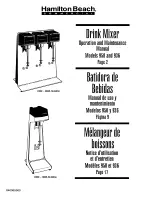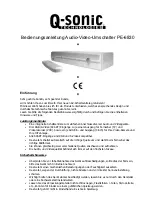
p. 98 Esmach S.p.A. Grisignano di Zocco (VI) - I
SPI 30-200 F
Instructions for use
and maintenance
4
MAINTENANCE
4.1
PREAMBLE
If not otherwise specified, each maintenance operation described herewith is to be considered routine
maintenance; any maintenance service, not mentioned in this manual, has to be considered unpredictable
maintenance ( for the definitions related to routine and unpredictable maintenance see par. 1.4). In case of
doubt, please contact ESMACH S.p.A.
ATTENTION!
Unless otherwise specified,
every maintenance work is to be carried out
only after :
- pressing the emercency button (17)
Picture 2
- disconneting the main power switch
(18) Picture 4
- removing the plug (
Picture 11
) from the electrical socket
;
after the plug removal
,
the plug has to
remain visible so that everybody can check the absence of mains supply to the machine and avoid any
machine part or machine parts start by others.
Should it be necessary to remove a protection guard or deactivate a safety device, take all measures
concerned to avoid any risks to thirds
( i.e. delimit the operation zone through red-white chains and
display warning signs of the risks for ongoing work); any protection guard is to be remounted and fixed by
means of the fixation tools concerned; each safety device reactivated as soon as the reasons for their
temporary removal/deactivation are ceased.
Whoever is a direct or indirect cause of damage to people, animals and things - owing to a non-observance
of the instructions given in the present manual and/or improper or, however, non-conforming use of the
machine- will take full responsability upon himself.
4.2
MAINTENANCE AND PERIODIC CONTROLS
Before starting any operation, carry out all safety measures as per par. 4.1.
•
At the end of the day or work shift, carry out an accurate
cleaning of the machine
(par.
Errore. L'origine
riferimento non è stata trovata.
)
•
At the beginning of each day or work day, ensure
the efficiency of the guards and the safety devices
in carrying out the controls described as per par.5.2.3.
4.3
ADJUSTMENT OF THE MOTION TRANSMISSION BELTS TENSION
Keep a Phillips and flat head screwdriver set and a set of hexagon wrenches at disposal.
4.3.1 HOW TO VERIFY THE CORRECT BELT TENSION
Check regularly the belt tension in the first 24/48 working hours (running in).
The belt tension is to be adjusted every time an irregular or difficult motion ( this is the sign that the belt is
slipping) in the rotation of the operating gears (bowl and spiral arm) is remarked.
With reference to Picture 13, to check if the belt tension is correct, proceed as follows:
a) Measure the length of the free stretch
L
, the value of which is shown in the sub-paragraphs concerned
below
b) In the centre of the free stretch
L
and perpendicularly to the same, the force
F
necessary to bend the belt
as per value
D
,
shown in the sub-paragraphs below, is equal to 1 mm every 100 mm of L ( for ex.: for a
free stretch of 500 mm, D = 5 mm); to check the flexion use a graph reference
c) The belt tension is correct if the force
F
applied to get a D flexion is between the values shown in the
different sub-paragraphs; to measure the force use a dynamometer or a tensiometer (this latter normally
is equipped with a reading system of D measure), both are easily available on the market.
For a better comprehension of the force data, remind that 9.81 [N] = 1 kg
















































